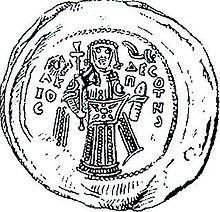Isaccea
The town has been inhabited for thousands of years, as it is one of the few places in all the Lower Danube that can be easily forded and thus be an easy link between the Balkans and the steppes of Southern Ukraine and Russia, north of the Black Sea.Another theory of the history the settlement is that a group of Russian refugees (see Lipovans) settled there and founded the monastery, but soon became outlaws who were eventually caught.The name Saka could in turn be derived from Romanian sacă/seacă, meaning "barren", however both the identification of the city with Isaccea and the etymology are mere speculations.The violent invasions of the Carpi, who plundered the cities and enslaved their inhabitants, left behind many archaeological traces, including buried coin hoards and signs of destruction.[21] The fortress of Noviodunum was probably destroyed during the raids of the Goths and Heruli, during the rule of Gallienus (267), buried hoards being found near it, including a larger treasure containing 1071 Roman coins.[21] During the rule of Constantine I (306-337), the Noviodunum fortress was rebuilt as part of a bigger project of restoring the Empire's borders along the Lower Danube.The tomb of four Roman Christian martyrs, discovered in September 1971 in nearby Niculiţel, bears the names Zotikos, Attalos, Kamasis and Philippos.[27] The Slavs began to settle in early 6th century and possibly the earliest reference to their settlement in the town is Jordanes' book (written in 551) The Origin and Deeds of the Goths, which mentioned Noviodunum as an extremity of the region were the "Sclaveni" lived.[29] Around 950, Constantine Porphyrogenitus talks of six desert cities in the area, one being named Saka-katai, which could be the earliest mentioning of the town after it was lost to the migrating people during the Dark Age.In 1036, the Pechenegs being driven southward by the Cumans, settled in Scythia Minor, including in this city, fact backed by archeological evidence, such as leaf-shaped pendants, characteristic to them.At the time, the city was a local Muslim centre and the residence of the famous Turkish dervish Sarı Saltuk, who has been associated with Nogai Khan's conversion to Islam.[36] Arab geographer Abulfeda mentioned the town, placing it in the territory of the "Al-Ualak" (Wallachs), having a population mostly Turkic and being ruled by the Byzantines.[37] A Byzantine despotate existed in Northern Dobruja with Isaccea as its centre, which sometimes between 1332 and 1337 became a vassal of the Golden Horde of Nogais under the name "Saqčï".In 1417, the town was conquered, together with other fortresses on the Danube, by the Ottomans,[40] who built a fort defended by a garrison as part of the Danubian frontier established by Mehmed I.We killed 23,884 Turks and Bulgars without counting those whom we burned in homes or whose heads were not cut by our soldiers....Thus your highness must know that I have broken the peace with him [the sultan].Țepeș's massacre and destruction completely changed the ethnic composition and the appearance of Isaccea, which remaining throughout the 16th century a small, largely Christian, village.[47] Sultan Osman II began a series of campaigns against the Cossacks and, as part of his fortification of the border, in 1620, a new fort was built in Isaccea, but in a different place.In December of that year, The Times of London noted that "Isaktchi" had a fortified castle and a garrison of 1500 men, but that it was simply a "port of observation" on the river.At the beginning of the Russo-Turkish War, 1877–1878, the Russians were able to take advantage of Romania's railways and mass a great number of troops in Galați.The first Russian unit crossed the Danube at Isaccea on the day when war was declared (August 27, 1916) and began their deployment toward Bulgaria, an ally of the Central Powers.In the 16th century, the town was located on the Moldavian-Ottoman border and its bazaar was one of the four most important trading posts in the Dobruja, with tradesmen coming from distant places, such as Chios or Ragusa.








CountyTulceaTime zonePostal codeArea codeVehicle reg.Tulcea CountyNorthern DobrujaRomaniaDanubefordedBalkansUkraineRussiaBlack Seaborder townBrăilaDN22/E87Măcin MountainsDobruja PlateauCommunist authoritiesagriculturefertilefloodplainTichilești, Tulcealeper colonyCantacuzinoLipovansIzmailPrince Nicholas of RomaniaȘtefan GheorghiuDe Administrando ImperioConstantine Porphyrogenitusdeserted citiesDniesterBulgariaPechenegAnna ComnenaAlexiadNicolae IorgaAbu'l-FidaWallachsTurkish languageIstanbulCelticDacianSlavicVicinaGenoeseNoviodunum (castra)NoviodunumTabula PeutingerianaVetrino–Isaccea–Yuzhnoukrainsk powerlineprehistoricneolithicBoian-Giulești cultureHellenisticGallic invasion of the BalkansAliobrixDurostorumDarius I of PersiaScythianstrade postGreeksPtolemyHieroclesMoesiamunicipiumRoman fleetClassis Flavia MoesicaLegio V MacedonicaLegio I ItalicaLegio I IoviaCostobociMoldaviahoardsHeruliGallienusConstantine ImartyrsNiculiţelcampaigns of persecutions of early ChristiansDiocletianLiciniusan important battleFlavius ValensThervingiAthanaricboat bridgeBessarabiaByzantine EmpireValipsRugiansHernacJordanesThe Origin and Deeds of the GothsKutrigursJustinian Iepiscopal seePhocasFirst Bulgarian EmpirekastronPechenegsCumansScythia MinorpendantsParistrionIsaac II AngelosJohn VatatzesManuel I KomnenosNogai KhanTarnovoSarı SaltukAbulfedavassalGolden HordeNogaisTatarsArabicMircea cel BătrânWallachiaOttomansMehmed IVlad ȚepeșOttoman EmpireMatthias Corvinus